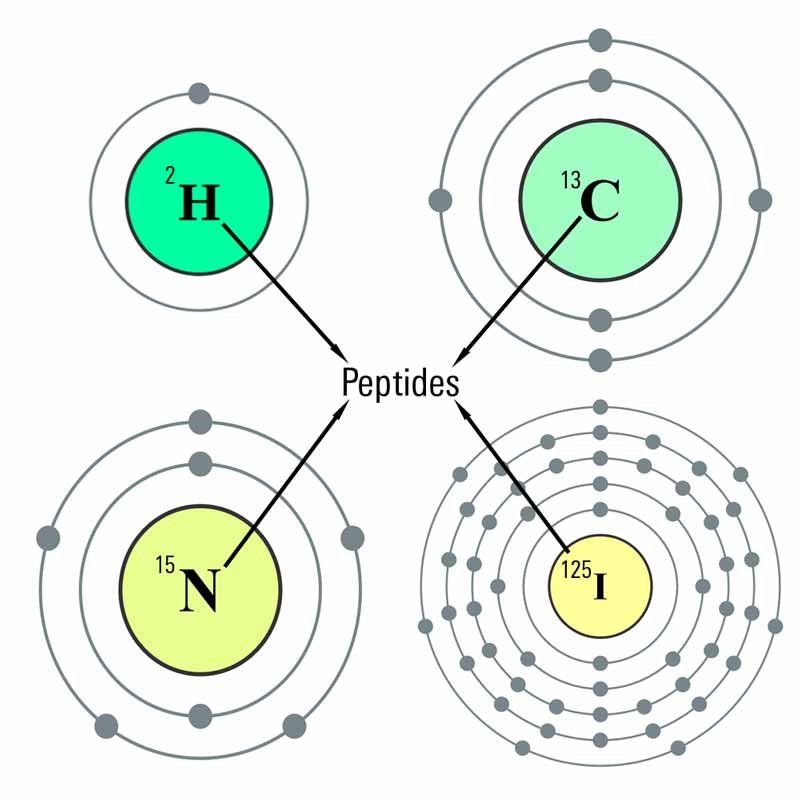Phoenix Pharmaceuticals offers a wide range of custom isotope labeling (2H, 13C, 15N and 125I ) for the peptide of your choice. In addition to isotope labeling service, the specific residue on peptide can be modified by acetylation, phosphorylation, amidation, succinylation, butyrylation and specific bridge cross-linking. For more details about inquiries, please contact our Customer Service Department at info@phoenixpeptide.com.

No consensus has been reached on the proper time to add stable-isotope labeled (SIL) peptides in protein cleavage isotope dilution mass spectrometry workflows. While quantifying 24 monolignol pathway enzymes in the xylem tissue of Populus trichocarpa, we compared the protein concentrations obtained when adding the SIL standard peptides concurrently with the enzyme or after quenching of the digestion (i.e. post-digestion) and observed discrepancies for nearly all tryptic peptides investigated. In some cases, greater than 30-fold differences were observed. To explain these differences and potentially correct for them, we developed a mathematical model based on pseudo-first-order kinetics to account for the dynamic production and decay (e.g. degradation and precipitation) of the native peptide targets in conjunction with the decay of the SIL peptide standards. A time course study of the digests confirmed the results predicted by the proposed model and revealed that the discrepancy between concurrent and post-digestion introduction of the SIL standards was related to differential decay experienced by the SIL peptide and the native peptide in each method. Given these results, we propose concurrent introduction of the SIL peptide is most appropriate, though not free from bias. Mathematical modeling of this method reveals that overestimation of protein quantities would still result when rapid peptide decay occurs and that this bias would be further exaggerated by slow proteolysis. We derive a simple equation to estimate the bias for each peptide based on the relative rates of production and decay. According to this equation, nearly half of the peptides evaluated here were estimated to have quantitative errors greater than 10% and in a few cases over 100%. We conclude that the instability of peptides can often significantly bias the protein quantities measured in protein cleavage isotope dilution mass spectrometry-based assays and suggest peptide stability be made a priority when selecting peptides to use for quantification.
Shuford CM et al., Mol Cell Proteomics. 2012 Sep;11(9):814-23. doi: 10.1074/mcp.O112.017145. Epub 2012 May 17.
Diagnostic development and public health surveillance require technologies that provide specific identification and absolute quantification of protein biomarkers. Beside immunologically related techniques (e.g. enzyme-linked immunosorbent assay), MS is gaining increasing interest due to its high sensitivity and specificity. Furthermore, MS-based analyses are extremely accurate quantitatively, provided that suitable reference standards are available. Recently, the use of chemically synthesized isotope-labeled marker peptides for MS-based absolute quantification of proteins has led to major advances. However, we show here that the use of such peptides can lead to severe biases. In this work, we present an innovative strategy (Protein Standard Absolute Quantification) that uses in vitro-synthesized isotope-labeled full-length proteins as standards for absolute quantification. As those protein standards perfectly match the biochemical properties of the target proteins, they can be directly added into the samples to be analyzed, allowing a highly accurate quantification of proteins even in prefractionated complex samples. The power of our Protein Standard Absolute Quantification methodology for accurate absolute quantification of biomarkers was demonstrated both on water and urine samples contaminated with Staphylococcus aureus superantigenic toxins as typical biomarkers of public health interest.
Brun V, Dupuis A, Adrait A et al., Mol Cell Proteomics. 2007 Dec;6(12):2139-49. Epub 2007 Sep 11.
BACKGROUND AND OBJECTIVES:
Prostate cancer (PCa) is one of the most common cancers and leading cause of cancer-related deaths in men. Mass screening has been carried out since the 1990s using prostate-specific antigen (PSA) levels in the serum as a PCa biomarker. However, although PSA is an excellent organ-specific marker, it is not a cancer-specific marker. Therefore, the aim of this study was to discover new biomarkers for the diagnosis of PCa.
MATERIALS AND METHODS:
We focused on urine samples voided following prostate massage (digital rectal examination [DRE]) and conducted a peptidomic analysis of these samples using matrix-assisted laser desorption/ionization time-of-flight mass spectrometry (MALDI-TOF/MSn). Urinary biomaterials were concentrated and desalted using CM-Sepharose prior to the following analyses being performed by MALDI-TOF/MSn: 1) differential analyses of mass spectra; 2) determination of amino acid sequences; and 3) quantitative analyses using a stable isotope-labeled internal standard.
RESULTS:
Multivariate analysis of the MALDI-TOF/MS mass spectra of urinary extracts revealed a 2331 Da peptide in urine samples following DRE. This peptide was identified as a C-terminal PSA fragment composed of 19 amino acid residues. Moreover, quantitative analysis of the relationship between isotope-labeled synthetic and intact peptides using MALDI-TOF/MS revealed that this peptide may be a new pathognomonic biomarker candidate that can differentiate PCa patients from non-cancer subjects.
CONCLUSION:
The results of the present study indicate that the 2331 Da peptide fragment of PSA may become a new pathognomonic biomarker for the diagnosis of PCa. A further large-scale investigation is currently underway to assess the possibility of using this peptide in the early detection of PCa.
Nakayama K, Inoue T, Sekiya S et al., PLoS One. 2014 Sep 18;9(9):e107234. doi: 10.1371/journal.pone.0107234. eCollection 2014.


